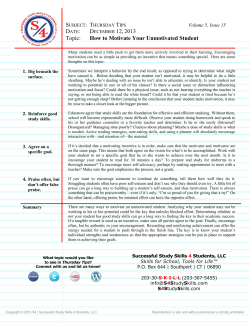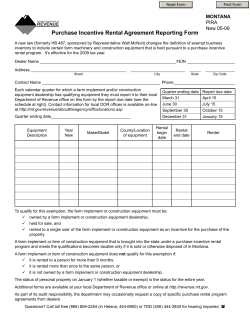
Document 311209
1 | P a g e RSA – Employment Tax Incentive (ETi) Process Manual Contents Introduction ...................................................................................................................................................................... 3 Background........................................................................................................................................................................ 3 Incentive calculation ......................................................................................................................................................... 3 Employment Tax Incentive (ETi) PAYE Overview ............................................................................................................... 4 Impact on Paymaster ........................................................................................................................................................ 5 2 | P a g e Introduction South Africa is well known for its high unemployment rates, especially among the youth. In an attempt to reduce this, government has proposed the implementation of the Employment Tax Incentive (ETi) scheme to encourage businesses to employ young people. The Bill was adopted and the implementation date is set as from 1 January 2014. In practical terms, it means the employer will receive an incentive for employing youths, subject to certain conditions, which will be in the form of a reduced PAYE monthly liability. The purpose of this document is to highlight the changes in the Republic of South African Employment Tax Incentive (ETi) bill and how these changes will impact your RSA payroll. Background The draft Employment Tax Incentive (ETi) Bill was published on 20 September 2013 and a revised Bill was published on 24 October 2013. The ETi which is aimed at encouraging employers to give young people their first job experience as well as boost employment by firms operating in the Special Economic Zones (SEZs). The Employment Tax Incentive Bill was passed by parliament on 18 December 2013 (Government Gazette Number 37185). The Employment Tax Incentive will reduce the cost to employers of hiring young people through a cost-sharing mechanism with government, while leaving the wage the employee receives unaffected. Employers who are registered for tax will be eligible to decrease their PAYE employees’ tax that is payable for hiring a qualifying individual. Qualifying employees are defined as employees with a South African ID card, who are between the ages of 18 and 29 years and 11 months and who were employed by the employer on or after 1 October 2013 and must receive a salary that is between the minimum wage for that specific sector and R6 000 per month. A minimum of R2 000 applies where no sectorial determination is applicable. The employee cannot be related or connected to the employer in any way. Domestic workers will not be eligible for the incentive. The incentive will be available for the first two years of employment. The value of the incentive is prescribed by a formula, which has three components for different wage levels. Incentive calculation The incentive amounts for each qualifying employee will be as follows: Monthly Remuneration R0 - R2 000 R2 000 - R4 000 R4 000 - R6 000 3 | P a g e Employment tax incentive per month during the first 12 months of employment of the qualifying employee Employment tax incentive per month during the next 12 months of employment of the qualifying employee “1st Year” “2nd Year” 50% of monthly remuneration 1000 Formula: R1 000 - (0.5 x (monthly remuneration R4 000)) 25% of monthly remuneration 500 Formula: R500 - (0.25 x (monthly remuneration R4 000)) For the purposes of the ETi definition of ‘‘monthly remuneration’’, ‘‘remuneration’’ has the meaning ascribed to it in paragraph (1) of the Fourth Schedule to the Income Tax Act “Remuneration for Employees’ Tax purposes is defined as any amount of income which is paid or is payable to any person by way of any salary, leave pay, wage, overtime pay, bonus, gratuity, commission, fee, emolument, pension, superannuation allowance, retiring allowance or stipend, whether in cash or otherwise and whether or not in respect of services rendered. (before taking any allowable deductions into account which the employer may have deducted for purposes of calculating employees tax).” Employment Tax Incentive (ETi) PAYE Overview Qualifying Employer Qualifying Employees • Registered for PAYE • Registered for Income Tax • Individual • Company • SIC Codes (verify or indenJty Industry) • Not a Parastatal / Government EnJty / Municipality EnJty • Not a Public EnJty listed in schedule 2 or 3 • Tax Compliant • Employed on/aRer 01 October 2013 • Valid RSA ID Number or • Possession of a valid Asylum Seeker Permit • 18 -‐ 29 yrs and 11 months old • Not a domesJc worker • Basic Salary / Wage must be at least R2000 per month or the minimum wage • Works mainly in a SEZ or is employed in a SIC CalculaJon of the IncenJve • Payroll will apply correct calculaJon based on the 1st and 2nd year of employment • Declare PAYE liability and ETi amount using the PAYE declaraJon process Allocate ETi Amount • Employers eligible monthly deducJon against PAYE • Apply roll over, capping, restricJon principles • if incenJve amount exceeds liable amount -‐ rolls to the next month Please note that the ETi is only effective from 01 January 2014 and not backdated to October 2013. The Qualifying employee employment date should be on or after 01 October 2013. 4 | P a g e Impact on Paymaster Ø The ETi calculations and qualifying employees will be determined by Paymaster automatically based on the Date of Birth, Valid SA ID Number, Employee Engagement Date and Nature of Person. The Nature of Person code A – Individual Person with ID Number / Passport or code M – Asylum Seeker. Ø In the following scenarios, the ETi will result in: Scenario: ETi result: Employee AWOL – reduced or no pay No ETi will calculate for the month Employee on Maternity – no pay No ETi will calculate for the month Employee on Maternity – reduced pay ETI may or may not calculate for the month – depending on the remuneration paid to the employee Prorata engagement or termination No ETi will calculate for the month Ø The Nature of Person on the employee tax profile: Navigate to Employee > Employee Tax Profile Nature of Person code A – Individual Person with ID Number / Passport or Nature of Person code M – Asylum Seeker (new code). Asylum Seeker definition: a person who has left their home country as a political refugee and is seeking asylum in another. "Only asylum seekers who are granted refugee status are allowed to work in the country". 5 | P a g e or Ø A company level exclusion flag has been introduced where the user has the flexibility to switch off the ETI calculation for the entire company: Navigate to: Company > Basic Company Information > UIF, SDL, Other This should only be ticked when the Company is any of the following: • • • 6 | P a g e Parastatal, Government Entity or Municipality Public Entity listed in schedule 2 or schedule 3 (please see schedule) Is not available for ETi due to Tax Compliance An employee level exclusion flag has been introduced where the user has the flexibility to switch off the ETI calculation for specific employees: Navigate to: Employee > Basic Employee Information > Basic Profile > Exceptions & Other This should only be ticked when the Employee is any of the following: a domestic worker in relation to the employer, is not a connected person as defined in section 1 of the Income Tax Act Is not available for ETi due to Tax Compliance • • • Ø If you are using the grades module on the system, you are able to specify a sectorial minimum wage per grade which will allow you to override the default applicable minimum. The minimum wage will be used to aid the system in determining the qualifying criteria. Navigate to Company > Organisation Structure > Grades 7 | P a g e The minimum salary per grade can be used for sectorial determination where applicable. Please note that this is based per grade and the position needs to be linked to a grade. Should this not be used, the system will default to R2 000 as the minimum. Ø A new tax code has been introduced: Tax Code 4118 has been introduced. The code will be displayed under the note section of the payslip and on the historical drill down. Payslip: Historical drill down: The Tax code 4118 will not be displayed on the employee issued IRP5, but will be included in the submission to SARS. 8 | P a g e Ø The new revised EMP201 return: Navigate to: Company > Reports > Legislative > EMP201 Ø The new revised EMP201 breakdown: Navigate to Company > Reports > Legislative > EMP201 breakdown Ø The new revised EMP201 breakdown: Navigate to: Company > Reports > Legislative > EMP201 breakdown Further Changes to follow: Ø The declaration process/requirements for the year end 2014 IRP5’s will be revised as per the Business Requirement Specification document released by SARS. Ø A Standard Industry Classification dropdown will be introduced on company level based on version 7 from Stats SA. This will form part of the yearend process. Ø The SEZ codes will be available on the Company Basic Information Screen once the bill has been passed by Parliament. 9 | P a g e
© Copyright 2025












